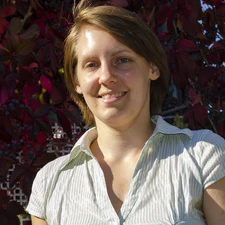Eva P. S. Eibl

SM Seismology
The 2021 Division Outstanding Early Career Scientist Award is awarded to Eva P. S. Eibl in recognition of her transformative contributions to our ability to understand, model, and monitor volcano-, geyser- and glacier-related processes using conventional and new seismological tools.
From modelling of volcano-glacier interaction to early warning of subglacial flooding, to the discrimination of volcanic versus helicopter-generated tremors, Eva Eibl is carrying out rigorous research that provides a game-changer for the understanding of non-conventional Earth processes with techniques grounded in array analysis, spanning from seismic source characterization to amplitude and single-station arrays. Eibl’s unique take on seismology has taught us how to extract the height, location, direction, and number of blades of a helicopter from Doppler effects, or how we can monitor the fracturing crust while magma flows silently. This unique research path has allowed her to secure an impressive streak of funding, awarded by some of the most important institutions in Europe.
Eibl has recently fully embraced the emerging field of rotational seismology, which is bringing us effective tools for dealing with the challenges of characterizing volcanic and glacial environments. Her interdisciplinary profile and the ability to integrate seismological datasets with those from different disciplines (geology, geography, modelling, glaciology) makes her a unique Early Career Scientist from a range of disciplines. Regardless, Eibl is a seismologist by background and research who has shown us a novel way to use our discipline to model and monitor challenging Earth and environmental settings. Her rigorous and creative work to date proves that she is equally able to understand and include complex theoretical and modelling frameworks in her research, apply innovative data processing tools, and tackle the challenges of experimental seismology.
Publication resulting from this award
Eibl, E. P. S., Vogfjörd, K. S., Ófeigsson, B. G., Roberts, M. J., Bean, C. J., Jones, M. T., Bergsson, B. H., Heimann, S., and Dietrich, T.: Subaerial and subglacial seismic characteristics of the largest measured jökulhlaup from the eastern Skaftá cauldron, Iceland, Earth Surf. Dynam., 11, 933–959, https://doi.org/10.5194/esurf-11-933-2023, 2023.
